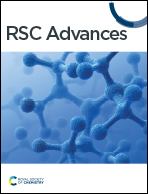Synthesis and characterization of TiO2/hydrochar matrix composites for enhanced ammonia degradation
Abstract
This study explores the limitations of TiO2 as a photocatalyst, focusing on its narrow bandwidth and high electron–hole complexation probabilities that restrict its applications. A novel one-pot synthesis method for TiO2/hydrochar matrix composites is presented, with variations achieved through control of hydrothermal temperature, time, and loading concentration. The efficacy of these composites in ammonia removal is investigated, revealing optimal performance for the composite denoted as 3Ti-160-7, synthesized with a titanium salt concentration of 0.3 mol L−1, a hydrothermal temperature of 160 °C, and a hydrothermal time of 7 hours. Comparative analyses with commercial TiO2 (P25) and hydrochar demonstrate superior performance of 3Ti-160-7, exhibiting significantly lower ammonia concentration and reduced NO and NO2 concentrations. This research underscores the cost-effectiveness and application potential of TiO2/hydrochar matrix composites, offering valuable insights for the enhancement of photocatalytic activity and broader applicability in addressing TiO2-related challenges.



 Please wait while we load your content...
Please wait while we load your content...